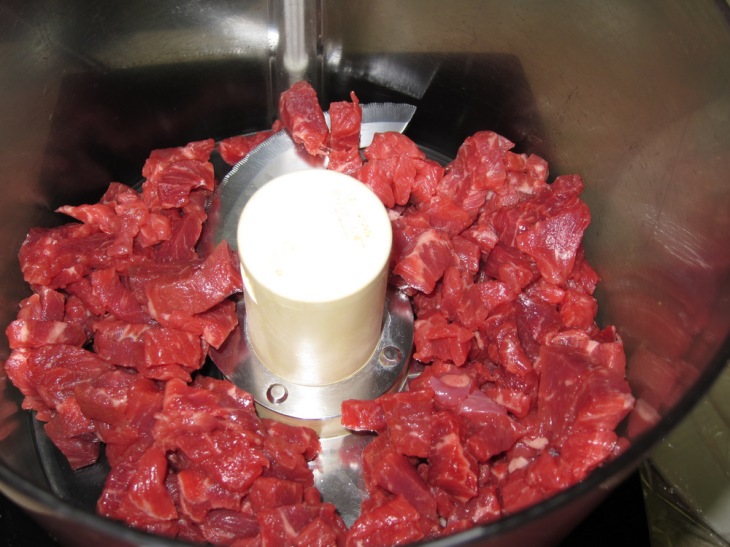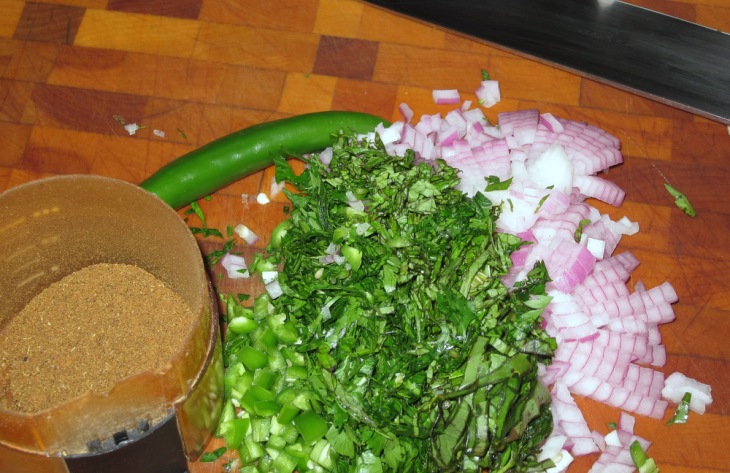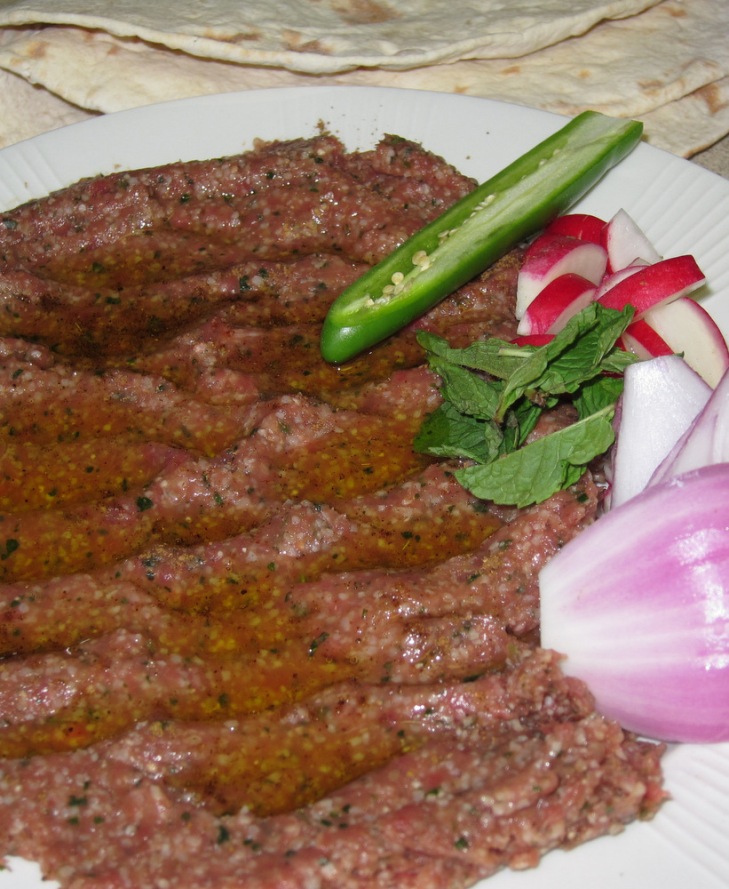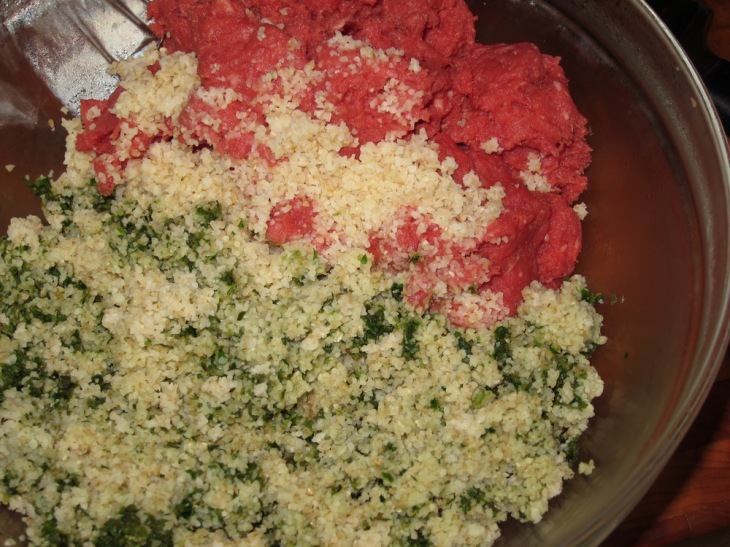Almost more than any other Lebanese dish, I crave Kibbeh Nayeh the most and immediately request that my mom or grandmother make a plate of this iconic dish as soon as I am back home visiting. Growing up this was our typical Sunday lunch. Back then I honestly did not appreciate it as much and would’ve happily wolfed down a plate of pizza or some fried chicken instead. Not now though. Now, I love a properly made raw kibbeh.
It really is about the proper ratio of fine, not coarse, burghul (cracked wheat) to meat. Too much burghul makes it too dense and crumbly (even if my grandmother likes it exactly like that). Too little burghul and it’s too much like beef tartar with the wrong texture. It should be served served drizzled with good extra virgin olive oil alongside fresh mint, raw sweet onions and radishes. It is traditionally made with lamb or, in the case of my family, with lean goat meat. Normally though I use lean beef or a mixture of beef and lamb.
Since this is raw meat it is good to keep in mind some safety considerations. Buy the meat whole NOT ground. Eating raw ground meat from a grocery store (even a high end pricey all natural one) is a bad idea. In beef any harmful pathogens usually are on the surface of the meat. Grinding a bunch of meat together at a grocery store or packing plant ensures that any nasties are mixed in through the meat. So, buy a whole piece of lean beef/lamb and rinse it well. This also removes anything that might be on the surface. Lastly, I like to freeze the meat for a couple of days at least before partially thawing and grinding. Freezing also helps in eliminating anything that might be on the meat. That being said, this is raw meat you are eating. I’ve never had an issue and I’ve been eating similar foods since the age of 10, but you never know.
Since my meat grinder was in storage at the time I used the food processor. It worked really well as long as I pulsed the mixture instead of letting it spin. The recipe I tried out this time is a bit non-traditional in that it incorporates some herbs in the meat mix as opposed to just meat, burghul, onions and some spices. The recipe comes from the Australian-Lebanese team of Greg and Lucy Malouf’s book MALOUF: New Middle Eastern Food. The book, like all of their other efforts, is filled with beautiful modernized and refined renditions of Lebanese and other middle eastern recipes. The Malouf Kibbeh incorporates green chilies, basil, mint and parsley into the meat, burghul and onion mix. It looks lovely with green speckles in it and has a delicious spicy herby flavor.
The Recipe
Kibbeh Nayeh with Herbs and Green Chiles
Adapted from MALOUF
- 75 gr. Fine burghul (#1)
- 90 gr. Onion, chopped
- 1 Green chile, seeded and chopped
- 1/3 Cup chopped basil
- 1/3 Cup chopped mint
- 1/3 Cup chopped parsley
- 300 gr. beef, lamb or a mixture, very lean
- 1 Tbsp. (or more) Lebanese spice mix – A combination of cumin, black pepper, dried marjoram, dried rose buds, a bit of cinnamon and allspice (or you can use just some black pepper, chili powder and cumin to taste)
Soak the burghul in cold water to cover for about 10 minutes. Drain well and squeeze as dry as possible.
Grind the onion, chile and herbs through using the fine die on the meat grinder (or use a food processor). Cut the meat into thin strips and mix with the spices and onion mixture. Grind the meat mixture twice to get a smooth paste (or if using a food processor, you would have to pulse it until smooth).
In a bowl, mix the meat and burghul with some salt and a couple of ice cubes. Use your hands to mix everything well until the ice melts. Taste and adjust salt or spice to your liking.
Spread the Kibbeh in a thin layer on a plate. Make dimples or ridges in it with a spoon or fork and drizzle with good olive oil. Serve it cold with fresh radishes, chilies, fresh mint leaves, raw sweet onions and pita bread.






Excellent! I am Beirut Lebanese living in Tennessee, U.S. and grew up having Kibbeh Nayeh. One thing I would add to this is you should either pound the meat or use a grinder (3 passes) and if you can’t then use the food processor.
Thanks Mark. You are right. I usually use the grinder, but when I made this particular recipe it was in storage and I had to make do with a food processor (A 14 cup capacity tough Cuisinart….not a wimpy cheapo one 🙂 ) and it worked well.
My mother is from Chile. Her father and his brothers all emigrated from Syria to Chile about 1915. I grew up in the US. My mother made a similar dish called, in Spanish, ‘copi’, pronounced CAW-pee. I grew up eating it.
When we traveled to Chile we found each branch of the family makes this dish, all strikingly similar. Beef, bulgar #1, minced parsley, salt, pepper, and ice water. Nothing else. It was only when I started researching the recipe to make it myself did I realize it was of middle eastern, not Chilean, origin. I made it tonight for my mother and brother and they pronounced it ‘just like mom’s’. I used sirloin, cubed it as in the picture, and pulsed it very well in the food processor (not a wimpy one either).
These food traditions are so important. Your recipe and tips were very helpful, thank you so much.
Thank you so much for sharing your feedback and story Helen! So glad the recipe worked for you and your family.
Mint and parsley are the new ingredients for me to add in Kibbeh. Will try them soon…
My grandma’s always had the little green flecks in it (she was Lebanese). It’s impossible to find kibbeh that looks and tastes like hers, I have a recipe I want to try someday, it has dried mint added– perhaps the source of the green flecks– but this looks very much like how hers looks. Most places frankly don’t have good kibbeh (well, I judge against my grandma’s). A lot of places bland and overprocessed into a sort of dog food-like paste